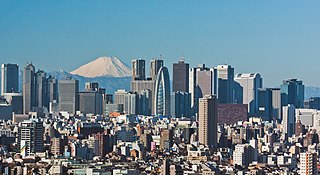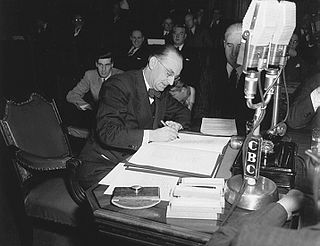St. Mary's Bay is one of many bays in Newfoundland, Canada, where bay is taken as a regional subdivision, somewhat along the lines of county divisions (Newfoundland, a largely maritime society, lacks counties). It is the most southern and eastern of Newfoundland's major bays.

Newfoundland and Labrador is the most easterly province of Canada. Situated in the country's Atlantic region, it comprises the island of Newfoundland and mainland Labrador to the northwest, with a combined area of 405,212 square kilometres (156,500 sq mi). In 2018, the province's population was estimated at 525,073. About 92% of the province's population lives on the island of Newfoundland, of whom more than half live on the Avalon Peninsula.

A bay is a recessed, coastal body of water that directly connects to a larger main body of water, such as an ocean, a lake, or another bay. A large bay is usually called a gulf, sea, sound, or bight. A cove is a type of smaller bay with a circular inlet and narrow entrance. A fjord is a particularly steep bay shaped by glacial activity.

A county is a geographical region of a country used for administrative or other purposes, in certain modern nations. The term is derived from the Old French conté or cunté denoting a jurisdiction under the sovereignty of a count (earl) or a viscount. The modern French is comté, and its equivalents in other languages are contea, contado, comtat, condado, Grafschaft, graafschap, Gau, etc..
Contents
- St. Mary's Bay and Resettlement
- Communities within St. Mary's Bay
- See also
- References
- External links
It is located on the southern shore of the Avalon Peninsula and is the heartland of the Irish Newfoundlanders, who live all along its shores, stretching west to the Cape Shore and Placentia and northeast to the Southern Shore and St. John's. Like most Irish Newfoundlanders, area residents trace their ancestry to County Waterford, County Wexford, County Kilkenny, south County Tipperary and east County Cork. In addition to being Irish, the region is also overwhelmingly Roman Catholic.

The Avalon Peninsula is a large peninsula that makes up the southeast portion of the island of Newfoundland. It is 9,220 square kilometres (3,560 sq mi) in size.

In modern Newfoundland, many Newfoundlanders are of Irish descent. According to the Statistics Canada 2006 census, 21.5% of Newfoundlanders claim Irish ancestry. The family names, the features and colouring, the predominance of Catholics in some areas, the prevalence of Irish music, even the accents of the people in these areas, are so reminiscent of rural Ireland that Irish author Tim Pat Coogan has described Newfoundland as "the most Irish place in the world outside of Ireland", though Coogan's historical accuracy has been widely criticized. Newfoundland has been called "the other Ireland" on a local radio talk show.

The Cape Shore is a region on the southwestern portion of the Avalon Peninsula on the island of Newfoundland, Canada.
St. Mary's Bay is an exceedingly rural area. None of the communities in the bay have a population in excess of 1000, and the bay as a whole is home to fewer than 5,000 people along (very roughly) the 150 km that make up 3 sides of its circumference, the 4th being uninhabitable ocean (note: because of bays, headlands, etc., the actual kilometres of shoreline are much more than 150).
St. Mary's Bay stretches approximately 40 kilometres (25 mi) wide at its mouth, from Point Lance in the west to Cape Freels in the east, and it extends almost 58 km (36 mi) to the NNE to its farthest point inland at Colinet.
Point Lance is a town in the Canadian province of Newfoundland and Labrador. The town had a population of 120 in the Canada 2011 Census. It has a beach.

Cape Freels is a headland on the island of Newfoundland, in the province of Newfoundland and Labrador, Canada, and the location of a community of the same name. This cape, located at the northern extremity of Bonavista Bay, is not to be confused with another Cape Freels which is located at the southern extremity of the Avalon Peninsula of Newfoundland.

Colinet is an incorporated town located on the northwest arm of St. Mary's Bay in Newfoundland and Labrador, Canada.
The next bay to the west is Newfoundland's largest bay, Placentia Bay. To the east of St. Mary's Bay is the much smaller Trepassey Bay.

Placentia Bay is a body of water on the southeast coast of Newfoundland, Canada. It is formed by Burin Peninsula on the west and Avalon Peninsula on the east. Fishing grounds in the bay were used by native people long before the first European fishermen arrived in the 16th century. For a time, the French controlled the bay. They built their capital at Placentia on the east coast. The British gained Placentia during the Treaty of Utrecht in 1713. The town and nearby Castle Hill are national historic sites. English settlement followed in the bay and today the main communities are Burin, Marystown, and Placentia.

Trepassey Bay is a natural bay located on the southeast end of the Avalon Peninsula of the island of Newfoundland, in the Canadian province of Newfoundland and Labrador.








